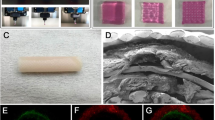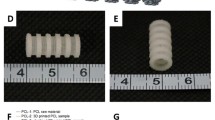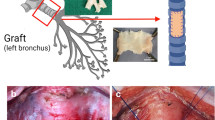Abstract
The purpose of this study was to clarify whether a polycaprolactone (PCL)-framed porous tracheal scaffold could be used for the replacement of the trachea in rabbits and produce better results in terms of luminal epithelialization. The tracheal scaffold consists of a PCL-framework and a collagen layer. After a longitudinal cervical skin incision, the trachea was exposed and a rectangular defect (1×0.5 cm) was created on the cervical trachea by a scalpel on eight rabbits. PCL-scaffold was trimmed and fixed to defect boundaries with Tisseel. Postoperatively, the site was evaluated endoscopically and histologically. Bronchoscopic examinations at 1 week revealed that implant exposure was recognized in the entire length of the prosthesis. The luminal surface of the implanted scaffold was partially covered at 2 weeks and completely covered at 4 weeks. Histologic data showed that the epithelial lining was nearly completed 1 week after surgery and some inflammatory cells were seen in the submucosa. At 2 weeks, the epithelium was already covered and the migration of inflammatory cells was not observed. However the concentration of cilia was not observed at this week. At 8 weeks there was also a neovascularization with luminal epithelialization. These findings suggest that a PCL-framed porous tracheal scaffold used in our experiment is an effective way to regenerate the epithelium on the surface of an artificial trachea.
Similar content being viewed by others
References
RT Cotton, The problem of pediatric laryngotracheal stenosis: a clinical and experimental study on the efficacy of autogenous cartilaginous grafts placed between the vertically divided halves of the posterior lamina of the cricoid cartilage, Laryngoscope, 101, 1 (1991).
P Monnier, F Lang, M Savary, Partial cricotracheal resection for severe pediatric subglottic stenosis, Ann Otol Rhinol Laryngol, 107, 961 (1998).
H Kojima, K Omori, A Fujita, et al., Thyroid gland flap for glottic reconstruction after vertical laryngectomy, Am J Otolaryngol, 11, 328 (1990).
HF Biller, W Lawson, V Weisberg, Staged repair of extensive trachea and laryngotracheal stenoses, Ann Otol Rhinol Laryngol, 95, 586 (1986).
EM Genden, S Govindaraj, Allograft tracheoplasty technique for management of refractory tracheal stenosis, Ann Otol Rhinol Laryngol, 115, 302 (2006).
HC Grillo, Tracheal replacement: a critical review, Ann Thorac Surg, 73, 1995 (2002).
Y Ikada, In situ tissue engineering: tissue engineering/fundamentals and applications, challenges in tissue engineering, Burlington, MA: Academic Press, 428 (2006).
P Macchiarini, T Walles, C Biancosino, et al., First human transplantation of a bioengineered airway tissue, J Thorac Cardiovasc Surg, 128, 638 (2004).
K Omori, Y Tada, T Suzuki, et al., Clinical application of in situ tissue engineering using a scaffolding technique for reconstruction of the larynx and trachea Ann, Otol Rhinol Laryngol, 117, 673 (2008).
K Kobayashi, T Suzuki, Y Nomoto, et al., A tissue engineered trachea derived from a framed collagen scaffold, gingival fibroblasts and adipose-derived stem cells, Biomaterials, 31, 4855 (2010).
M Komura, H Komura, Y Kanamori, et al., An animal model study for tissue-engineered trachea fabricated from a biodegradable scaffold using chondrocytes to augment repair of tracheal stenosis, J Pediatr. Surg, 43, 2141 (2008).
Y Tatekawa, Y Ikada, H Komuro, et al., Experimental repair of tracheal defect using a bioabsorbable copolymer, J Surg Res, 160, 114 (2010).
K Rezwan, QZ Chen, JJ Blaker, et al., Biodegradable and bioactive porous polymer/inorganic composite scaffolds for bone tissue engineering, Biomaterials, 27, 3413 (2006).
T Cao, KH Ho, SH Teoh, Scaffold design and in vitro study of osteochondral coculture in a three-dimensional porous polycaprolactone scaffold fabricated by fused deposition modeling, Tissue Eng, 9, 103 (2003).
TB Woodfield, J Malda, J de Wijn, et al., Design of porous scaffolds for cartilage tissue engineering using a threedimensional fiber-deposition technique, Biomaterials, 25, 4149 (2004).
JM Williams, A Adewunmi, RM Schek, et al., Bone tissue engineering using polycaprolactone scaffolds fabricated via selective laser sintering, Biomaterials, 26, 4817 (2005).
MJ Mondrinos, R Dembzynski, L Lu, et al., Porogen-based solid freeform fabrication of polycaprolactone-calcium phosphate scaffolds for tissue engineering, Biomaterials, 27, 4399 (2006).
SJ Hollister, Porous scaffold design for tissue engineering, Nat Mater, 4, 518 (2005).
ZG Tang, JT Callaghan, JA Hunt, The physical properties and response of osteoblasts to solution cast films of PLGA doped polycaprolactone, Biomaterials, 26, 6618 (2005).
I Zein, DW Hutmacher, KC Tan, et al., Fused deposition modeling of novel scaffold architectures for tissue engineering applications, Biomaterials, 23, 1169 (2002).
JW Lee, PX Lan, B Kim, et al., Fabrication and characteristic analysis of a poly(propylene fumarate) scaffold using micro-stereolithography technology, J Biomed Mater Res B Appl Biomater, 87, 1 (2008).
PX Lan, JW Lee, YJ Seol, et al., Development of 3D PPF/DEF scaffolds using micro-stereolithography and surface modification, J Mater Sci Mater Med, 20, 271 (2009).
O Laccourreye, P Naudo, D Brasnu, et al., Traeheal resection with end-to-end anastomosis for isolated postintubation cervical trachea stenosis: long-term results, Ann Otol Rhinol Laryngol, 105, 944 (1996).
RT Cotton, The problem of pediatric laryngotracheal stenosis: a clinical and experimental study on the efficacy of autogenous cartilaginous grafts placed between the vertically divided halves of the posterior lamina of the cricoid cartilage, Laryngoscope, 101, 1 (1991).
RA Daniel, The regeneration of defects of the trachea and bronchi: an experimental study, J Thorac Surg, 17, 335 (1948).
T Sato, M Araki, N Nakajima, et al., Biodegradable polymer coating promotes the epithelization of tissue-engineered airway prostheses, J Thorac Cardiovasc Surg, 139, 26 (2010).
WE Neville, JP Bolanowski, GG Kotia. Clinical experience with the silicone tracheal prosthesis, J Thorac Cardiovasc Surg, 99, 604 (1990).
MA Scherer, R Ascherl, K Geissdorfer, et al., Experimental biosynthetic reconstruction of the trachea, Arch Otorhinolaryngol, 243, 215 (1986).
JM AA Williams, RM Schek, CL Flanagan, et al., Bone tissue engineering using polycaprolactone scaffolds fabricated via selective laser sintering, Biomaterials, 23, 4817 (2005).
SM Li, XH Chen, RA Gross, et al., Hydrolytic degradation of PCL/PEO copolymers in alkaline media, J Mater Sci Mater Med, 11, 227 (2000).
M Vert, S Li, H Garreau, New insights on the degradation of bioresorbable polymeric devices based on lactic and glycolic acids, Clin Mater, 10, 3 (1992).
CXF Lam, DW Hutmacher, JT Schantz, et al., Evaluation of polycaprolactone scaffold degradation for 6 months in vitro and in vivo, J Biomed Mater Res A, 90, 906 (2009).
Author information
Authors and Affiliations
Corresponding author
Rights and permissions
About this article
Cite this article
Joo, YH., Park, JH., Cho, DW. et al. Morphologic assessment of polycaprolactone scaffolds for tracheal transplantation in a rabbit model. Tissue Eng Regen Med 10, 65–70 (2013). https://doi.org/10.1007/s13770-013-0358-8
Received:
Revised:
Accepted:
Published:
Issue Date:
DOI: https://doi.org/10.1007/s13770-013-0358-8




